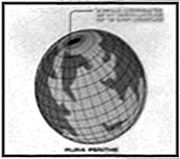(Added a section on the events around Rura Penthe in the current film.) |
No edit summary |
||
| Line 18: | Line 18: | ||
==Alternate Timeline History== |
==Alternate Timeline History== |
||
| − | In [[2258]] |
+ | In [[2258]] {{alt|Nyota Uhura}} intercepted a signal from the vicinity of Rura Penthe where 47 Klingon vessels are destroyed in battle. It is implied that the vessel the Klingons engaged is the [[Narada]] although this may have been used by [[James T. Kirk (alternate reality)|Kirk]] to convince [[Christopher Pike (alternate reality)|Pike]] that they are taking the {{USS|Enterprise|alternate reality}} into a hostile situation. ({{film|11}}) |
==Personnel and prisoners== |
==Personnel and prisoners== |
||
Revision as of 05:56, 10 May 2009

A Schematic of Rura Penthe from Operation Retrieve (2293)
Rura Penthe was a penal colony asteroid of the Klingon Empire. Located in the trinary Rura Penthe system within two sectors of the Federation border, it was widely known as "the aliens' graveyard".
Overview

The glaciated surface of Rura Penthe (2152)
The asteroid contained one of the most important sources of dilithium ore in the Klingon Empire. To mine the precious material, a penal colony for both Klingon and alien prisoners was established there, providing sufficient labor force for the extensive exploitation of the asteroid's resources.
The surface temperature of Rura Penthe was extremely low, and the landscape was dominated by glaciers. Without proper clothing, no humanoid lifeform was able to survive for very long on the surface, so most of the mining and prison facility was located underground. A magnetic shield encased the mining facility and a vast area surrounding it in order to prevent prisoners from being beamed away. The prison complex was patrolled by armed guards. Other security measures were minimal, as they were deemed largely unnecessary due to the harsh surface climate. (Star Trek VI: The Undiscovered Country)
History
A part of the dilithium mine complex on Rura Penthe (2293)

A triple sunrise on Rura Penthe in 2293
Rura Penthe had been a penal colony of the Klingon Empire since at least the early 22nd century. Banishment to its submontane dilithium mines was one of the most feared punishments throughout the Klingon Empire and its enemies. It was said that almost no one survived more than a year in the mines.
In 2152, Earth Starfleet Captain Jonathan Archer and his former Klingon advocate Kolos were sentenced by a tribunal on Narendra III to labor on Rura Penthe (Archer for the remainder of his life and Kolos for a period of one year). However, Archer was soon rescued by his crew, whereas Kolos decided to stay. (ENT: "Judgment")
In 2293, Starfleet Captain James T. Kirk and Commander Leonard McCoy were sentenced to a life of hard labor on Rura Penthe. They managed to escape after a few days, though it later emerged that their escape was facilitated so that the Klingon guards could kill them in the attempt. The setup failed, however, as Kirk and McCoy were successfully beamed aboard the USS Enterprise-A after trekking across the glaciers to escape the magnetic shield, thanks to a tracking device that was placed on Kirk's shoulder by Spock just before Kirk and McCoy left the Enterprise to investigate the events that eventually led to their arrest. (Star Trek VI: The Undiscovered Country)
Alternate Timeline History
In 2258 Nyota Uhura intercepted a signal from the vicinity of Rura Penthe where 47 Klingon vessels are destroyed in battle. It is implied that the vessel the Klingons engaged is the Narada although this may have been used by Kirk to convince Pike that they are taking the USS Enterprise into a hostile situation. (Star Trek)
Personnel and prisoners
- See: Rura Penthe personnel
Background
- Rura Penthe was a reference to the 1954 movie adaption of Jules Verne's 20,000 Leagues Under the Sea, in which Rura Penthe was a slave labor camp that inspired Captain Nemo's rage against society.
- In 2293 when Captain James T. Kirk and Doctor Leonard McCoy were imprisoned in Rura Penthe, it was stated that no one had ever escaped Rura. Obviously this was not true, as Captain Jonathan Archer escaped in 2152, but it could be speculated that this was propaganda to discourage criminals from attempting to escape.
- The surface scenes of Rura Penthe in Star Trek VI were filmed at Knik Glacier, east of Palmer, Alaska, while interior shots were partly filmed at Bronson Caves in Griffith Park in Los Angeles, California. The rest of the interiors and exteriors were done on Paramount Stage 15. For Rura Penthe's appearance in Enterprise, the interior shots were filmed at Paramount Stage 9 on a set that was built by a construction crew headed by Tom Purser and Thomas J. Arp.
- In all, there were 40 aliens and 15-20 Klingon guards used in the scene featured in Enterprise. Several of the actors were the same ones who appeared in Star Trek VI.
- In etymology terms, Rura Penthe means "wasteland of misery" coming from roots shared by the words "rural"[1] and "Nepenthe."[2]
